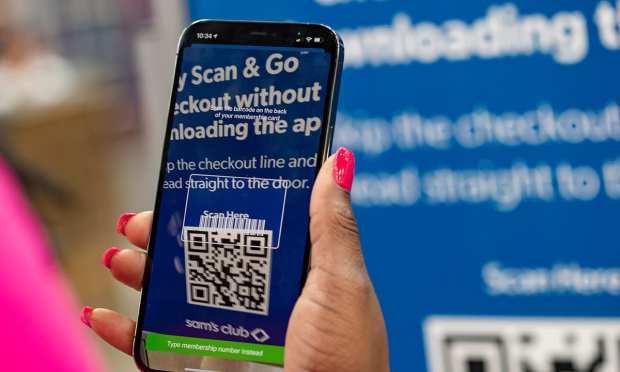Sam’s Club Touts 90 Pct Re-Use Rate For Its Touchless Checkout And Delivery Tech

With the rise in online grocery occasioned by the pandemic, consumers have grown used to being in control of their shopping journey. The digital buying experience is, after all, entirely self-guided. Now, with the return to shopping in brick-and-mortar grocery stores, many consumers are noticing, more than ever before, how much of the experience is left up to other people, relying on associates for information about inventory and waiting in long lines for cashiers to ring one’s items up. Leading retailers are finding ways to put the experience back into shoppers’ hands, as they have come to expect.
For instance, Sam’s Club, Walmart’s chain of membership-only warehouse clubs, recently announced that it has a Scan & Ship feature at three of its locations. The feature allows shoppers to scan items in stores from their mobile devices to be shipped to their homes within the next several business days. Through this feature, the chain aims to remain at the forefront of the rise in self-service.
“I think it’s a number of factors driving self-serve … I think it’s contactless, it’s the convenience factor, it’s not wanting to have to come into the club,” Tim Simmons, senior vice president and chief product officer at Sam’s Club, told Karen Webster in an interview. “In terms of where it goes, I really think we’re on the cutting edge of self-service with Scan & Go and Scan & Ship … I can’t think of an easier way to do self-serve.”
To that point, the Scan & Ship option builds on the company’s success with its Scan & Go feature, which allows shoppers to check themselves out as they move through the store, scanning products on their mobile devices. In Walmart’s most recent quarter, Sam’s Club saw a 43.5 percent year-over-year increase in the feature’s adoption rate, and those who try the feature have a 90 percent chance of using it again.
Where Does It Hurt?
The idea for the Scan & Ship feature came out of an innovation jam in which employees were thinking of solutions for common pain points along the path to purchase.
“We always try to put our members at the center of everything and then understand that end-to-end journey,” said Simmons. “As we look at that, and research it, and get opinions from our members, or see things that frustrate them … we see opportunities.”
The company identified that when a consumer sees a large item in the store that they would like to buy but cannot fit in their car, it creates a pain point. By integrating its mobile app-scanning technology with its direct-to-home order fulfillment capability, the retailer is able to create a more seamless experience.
Now, during the pilot testing stage, the company is making notes not only of how well the technology is working, but also how to integrate the feature into the shopping journey. Simmons explained, “Now that we have this MVP product, and we’ve got it in the three clubs, we’re of course looking closely at the tech … but we’re also looking overall at whether [members] are finding it OK. Is the signage working? Do they understand what we’re telling them they can do here?”
Can’t Touch This
Part of the appeal of these self-service features is that they remove points of contact with other people from the experience. While the conditions that led to the rise of contactless — the pervasive fear of catching COVID-19 from other people — has subsided, Simmons predicts that the demand for contactless solutions will persist into the future.
“I think contactless will be around for a while,” he said. “I think we’ve all been trained now to be really careful what we touch, and if we do touch things, to make sure to clean our hands immediately.”
Along with the rise in contactless comes a desire to get in and out of stores faster. In addition to speeding up checkout — both with self-service tools and updates to traditional checkout lanes — Sam’s Club is also looking to speed up the in-store experience with item-finding tools.
“In our research, if members say they could find their item easily, their net promoter score goes up. If they have a struggle with it, it goes down,” said Simmons. “So we have a number of initiatives that we’re looking at for helping members find their items.”
What’s In Store
In building this integrated omnichannel shopping journey, one of the highest hurdles left to clear is inventory — tracking it in real time, ensuring that every part of the supply chain stays informed with up-to-date information, predicting changes and keeping the consumer in the loop.
“I think there’s huge potential for AI, robotics and computer vision around inventory accuracy,” said Simmons. “Traditionally, understanding inventory and inventory reports is always yesterday’s news, so we’re already late.”
He added that as Sam’s Club tries out new leading-edge technologies, the goal is to “get more real-time or even predictive” when it comes to keeping up with customer demand and keeping shoppers informed about out-of-stock items.
While these innovations may be coming down the line, the near-term technological focus is on making the Scan & Ship feature as shopper-friendly as possible as it rolls out to more locations, aiming to meet consumers’ growing expectations for tools that make the in-store experience as seamless as possible.
“I believe these things will always follow the path of least resistance for the member,” said Simmons. “So if it’s simpler for a member to take out a phone, scan QR codes and check out, I think that’s the future of it.”
